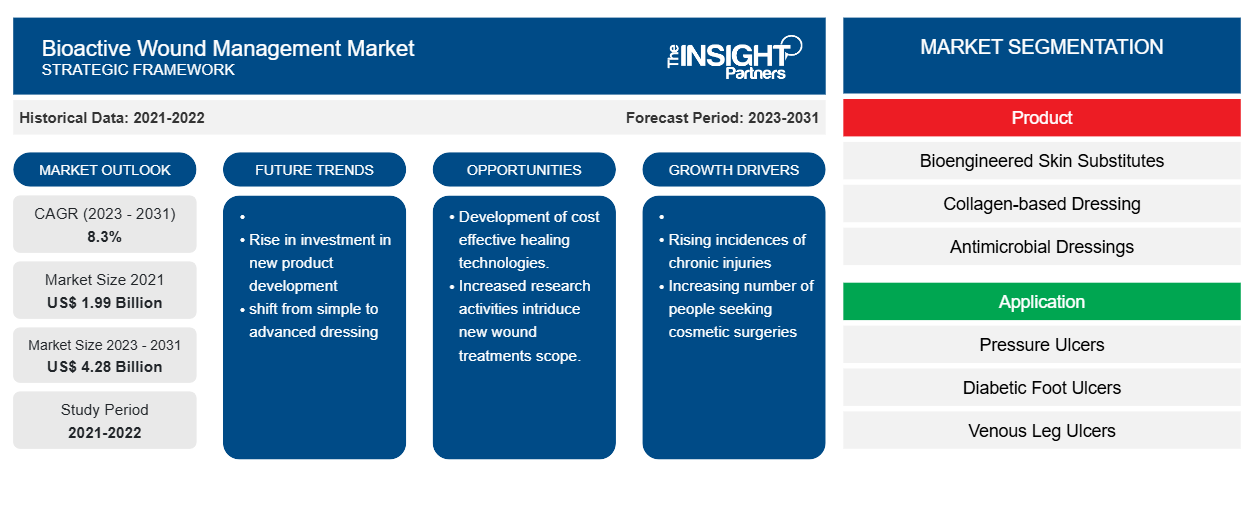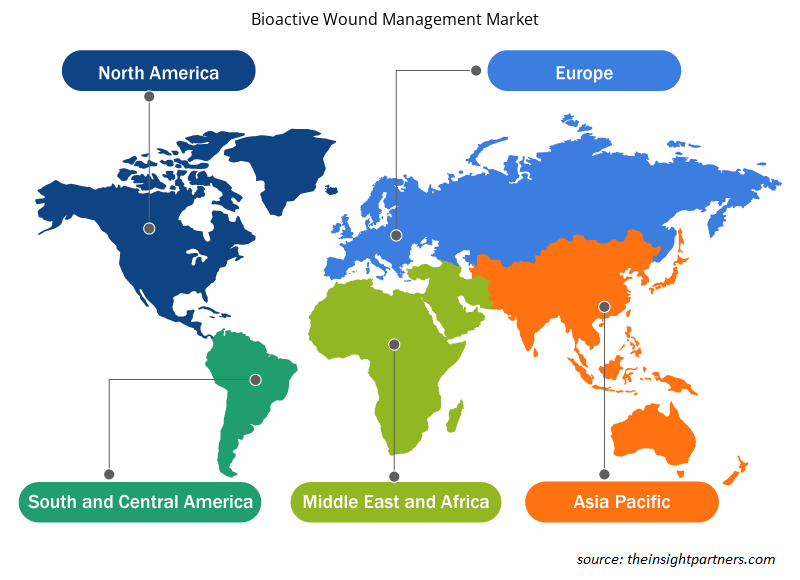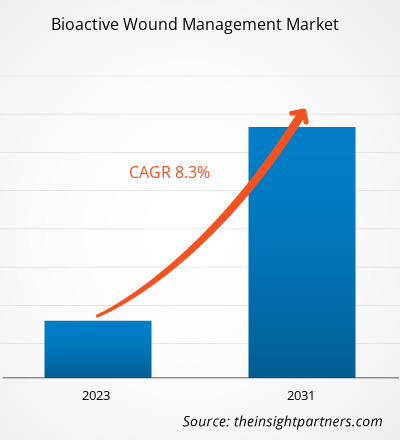Se estimó que el tamaño del mercado de gestión de heridas bioactivas sería de US$ 1.99 mil millones en 2021 y US$ XX mil millones en 2023 y se espera que alcance los US$ 4.28 mil millones para 2031; se estima que registrará una CAGR del 8,3% para 2031. Es probable que la impresión 3D en el manejo del cuidado de heridas siga siendo una tendencia clave del mercado de gestión de heridas bioactivas.
Análisis del mercado de tratamiento de heridas con bioactivos
El aumento de la incidencia de lesiones crónicas y un mayor número de procedimientos quirúrgicos están contribuyendo al crecimiento del mercado de tratamiento bioactivo de heridas. A nivel mundial, se prevé que la prevalencia de infecciones en el sitio quirúrgico aumente debido al creciente número de cirugías. Un aumento en el número de procedimientos quirúrgicos a nivel mundial se debe a la creciente prevalencia de diversas enfermedades crónicas. Según los datos proporcionados por los Institutos Nacionales de Salud (NIH), cada año se realizan ~20 millones de cirugías mayores en Europa. Según la Autoridad de Salud de Dubái (DHA), en 2021 se realizaron ~159.000 cirugías en Dubái. Según la misma fuente, el número de personas que buscan cirugías estéticas en Dubái se duplicó de 223.507 en 2020 a 583.909 en 2022. Los productos bioactivos para el tratamiento de heridas permiten una rápida curación de la infección del sitio quirúrgico; se prevé que el creciente número de procedimientos quirúrgicos aumente la demanda de estos productos en un futuro próximo.
Descripción general del mercado de tratamiento bioactivo de heridas
La región de América del Norte tuvo la mayor participación en el mercado de tratamiento bioactivo de heridas. Es probable que el aumento significativo de las inversiones para el desarrollo de nuevos productos, así como la presencia de los principales gigantes farmacéuticos en la región, sean responsables del dominio del mercado. Los actores norteamericanos tienen una red global de centros de distribución que ayuda a las empresas a llegar a múltiples ubicaciones en todo el mundo. Se proyecta que la región de Asia Pacífico será la región de más rápido crecimiento entre todas las demás regiones. Se espera que el crecimiento del mercado de tratamiento bioactivo de heridas sea más rápido en países como India, China y Australia. Se espera que el crecimiento del mercado en estos países sea más rápido debido a la creciente prevalencia de heridas crónicas , el aumento de la población diabética y envejecida y la mejora de las instalaciones de atención médica. Además, la presencia de organismos de gestión activa del cuidado de heridas en la región ofrece oportunidades lucrativas para el crecimiento del mercado.
Personalice este informe según sus necesidades
Obtendrá personalización en cualquier informe, sin cargo, incluidas partes de este informe o análisis a nivel de país, paquete de datos de Excel, así como también grandes ofertas y descuentos para empresas emergentes y universidades.
Mercado de tratamiento de heridas con bioactivos: Wound Management Market: perspectivas estratégicas

- Obtenga las principales tendencias clave del mercado de este informe.Esta muestra GRATUITA incluirá análisis de datos, desde tendencias del mercado hasta estimaciones y pronósticos.
Impulsores y oportunidades del mercado de tratamiento bioactivo de heridas Wound Management Market Drivers and Opportunities
La innovación en productos avanzados para el cuidado de heridas favorecerá el mercado
Se están desarrollando varias tecnologías de curación de heridas rentables para satisfacer la creciente demanda. Los avances en el tratamiento de heridas han llevado a un cambio de los apósitos simples a productos avanzados para el cuidado de heridas. Los apósitos avanzados para heridas se han diseñado para crear un entorno húmedo que promueve la curación. Los productos para el cuidado de heridas a base de queratina se utilizan a menudo junto con estos apósitos para ayudar a la reepitelización de la herida. Estos productos facilitan una curación más rápida al ser absorbidos por las heridas, lo que elimina la necesidad de cambiar el apósito con frecuencia. Además, el uso de materiales de andamiaje biológico que incluyen una matriz extracelular (ECM) intacta o componentes individuales de la ECM proporciona nuevas opciones terapéuticas que se centran en el microambiente de la herida y facilitan la rápida restauración de la piel. re-epithelialization. These products facilitate faster healing by being absorbed into the wounds, which eliminates the need to frequently change the dressing. Furthermore, the usage of biological scaffold materials including an intact extracellular matrix (ECM) or individual components of the ECM provides new therapeutic options that focus on the wound microenvironment and facilitate rapid restoration of skin.
A continuación se mencionan algunos avances en productos para el cuidado de heridas:
• Integra Life Sciences ofrece una amplia gama de productos para el tratamiento de heridas, como Integra Bilayer Wound Matrix, Integra Meshed Bilayer Wound Matrix y Integra Flowable Wound Matrix. Estos productos están compuestos de colágeno bovino reticulado, glicosaminoglicano y una cubierta de silicona. Se utilizan para el tratamiento de heridas de espesor parcial y total, úlceras por presión, úlceras venosas, úlceras diabéticas, úlceras vasculares crónicas y heridas quirúrgicas.
•Matristem (ACell Inc.) es un andamio de matriz extracelular natural que consiste en UBM-ECM porcino no reticulado. La principal ventaja de UBM-ECM sobre otros productos de matriz extracelular natural es que retiene el componente de la membrana basal de la vejiga urinaria en una superficie del andamio biológico. La membrana basal funciona para anclar los tejidos epiteliales a la matriz extracelular en órganos como la piel y los vasos sanguíneos.
Aumentar las actividades de investigación para introducir nuevos tratamientos para las heridas: una oportunidad
Las heridas crónicas pueden causar dificultades a los cirujanos a la hora de tratarlas de forma eficaz, lo que da lugar a más complicaciones. Con un número cada vez mayor de pacientes que sufren heridas crónicas, existe una creciente necesidad de un enfoque sistemático para el tratamiento, lo que ha impulsado la adopción de una atención basada en la evidencia. La investigación y los ensayos clínicos han demostrado que el uso de productos bioactivos para el cuidado de las heridas puede mejorar la cicatrización de las heridas húmedas. Los organismos gubernamentales y las universidades de investigación desempeñan un papel activo en la promoción de avances en el cuidado de las heridas, y varias organizaciones de investigación se dedican a desarrollar productos avanzados para el cuidado de las heridas. Es probable que esto genere oportunidades de crecimiento durante el período de pronóstico.
A continuación se mencionan algunos ejemplos a este respecto:
- En julio de 2023, investigadores de la Queen's University de Belfast desarrollaron un nuevo tratamiento para las úlceras del pie diabético (UPD) utilizando un vendaje impreso en 3D conocido como andamio. Esta innovadora tecnología combina nanopartículas lipídicas e hidrogeles para crear andamios personalizados similares a la piel que liberan moléculas cargadas de antibióticos de forma masiva y sostenida para tratar las UPD. Este descubrimiento tiene el potencial de mejorar significativamente el tratamiento de las úlceras diabéticas.
- En junio de 2023, investigadores de la Universidad de Birmingham presentaron una nueva técnica que demostró cómo la plata podía conservar sus propiedades antimicrobianas durante períodos más prolongados cuando se impregnaba en un "vidrio bioactivo". Se descubrió que esta combinación brindaba una protección antimicrobiana contra las heridas más eficaz y duradera en comparación con las alternativas más convencionales. Vidrios bioactivos: una clase única de biomateriales sintéticos que se han fabricado a partir de silicona y se han utilizado durante varios años en injertos óseos.bioactive glass'. This combination was found to deliver more effective and long-lasting antimicrobial wound protection when compared to more conventional alternatives. Bioactive glasses-a unique class of synthetic biomaterials that have been made from silicone and have been used for several years in bone grafting.
Análisis de segmentación del informe de mercado de gestión de heridas bioactivas Wound Management Market Report Segmentation Analysis
Los segmentos clave que contribuyeron a la derivación del análisis del mercado de manejo bioactivo de heridas son el producto, la aplicación y el usuario final.bioactive wound management market analysis are product, application, and end user.
- Según el producto, el mercado de tratamiento bioactivo de heridas se segmenta en sustitutos de piel bioingeniería, apósitos a base de colágeno, apósitos antimicrobianos, alginatos e hidrocoloides. El segmento de alginatos tuvo la mayor participación de mercado en 2023.bioactive wound management market is segmented into bioengineered skin substitutes, collagen-based dressing, antimicrobial dressings, alginates, and hydrocolloids. The alginates segment held the largest market share in 2023.
- Por aplicación, el mercado está segmentado en úlceras por presión, úlceras del pie diabético, úlceras venosas de las piernas, heridas por quemaduras y heridas quirúrgicas. El segmento de heridas por quemaduras tuvo la mayor participación del mercado en 2023.
- En términos de usuarios finales, el mercado está segmentado en hospitales y clínicas, centros quirúrgicos ambulatorios y otros. El segmento de hospitales y clínicas dominó el mercado en 2023.
Análisis de la cuota de mercado de los tratamientos bioactivos para heridas por geografía
El alcance geográfico del informe de mercado de gestión de heridas bioactivas se divide principalmente en cinco regiones: América del Norte, Asia Pacífico, Europa, Oriente Medio y África, y América del Sur/América del Sur y Central. América del Norte ha dominado el mercado de gestión de heridas bioactivas. Se espera que el mercado de gestión de heridas bioactivas en los EE. UU. sea el más grande y de más rápido crecimiento debido a varios factores. Algunos de los factores impulsores incluyen la presencia de varios fabricantes de dispositivos médicos que producen dispositivos y productos bioactivos para el tratamiento de heridas y el apoyo del gobierno al proporcionar herramientas, tecnología y experiencia avanzadas para un cuidado óptimo de las heridas. Las empresas de EE. UU. están aumentando su presencia siguiendo estrategias orgánicas e inorgánicas. Por ejemplo, en octubre de 2021, Medline Industries anunció una inversión de 77,5 millones de dólares para construir un nuevo centro de distribución en Kansas. Por lo tanto, la creciente necesidad en los EE. UU. de apósitos para heridas indica una oportunidad sustancial para que los actores clave desarrollen la gestión del cuidado de heridas con productos innovadores. Se prevé que Asia Pacífico crezca con la CAGR más alta en los próximos años.
Perspectivas regionales del mercado de tratamiento de heridas con bioactivos
Los analistas de Insight Partners explicaron en detalle las tendencias y los factores regionales que influyen en el mercado de tratamiento de heridas con bioactivos durante el período de pronóstico. Esta sección también analiza los segmentos y la geografía del mercado de tratamiento de heridas con bioactivos en América del Norte, Europa, Asia Pacífico, Oriente Medio y África, y América del Sur y Central.

- Obtenga datos regionales específicos para el mercado de tratamiento bioactivo de heridas
Alcance del informe de mercado sobre el tratamiento bioactivo de heridas
| Atributo del informe | Detalles |
|---|---|
| Tamaño del mercado en 2021 | 1.990 millones de dólares estadounidenses |
| Tamaño del mercado en 2031 | US$ 4.28 mil millones |
| CAGR global (2023 - 2031) | 8,3% |
| Datos históricos | 2021-2022 |
| Período de pronóstico | 2023-2031 |
| Segmentos cubiertos | Por producto
|
| Regiones y países cubiertos | América del norte
|
| Líderes del mercado y perfiles de empresas clave |
|
Densidad de actores del mercado de tratamiento de heridas bioactivo: comprensión de su impacto en la dinámica empresarial
El mercado de tratamiento de heridas bioactivo está creciendo rápidamente, impulsado por la creciente demanda de los usuarios finales debido a factores como la evolución de las preferencias de los consumidores, los avances tecnológicos y una mayor conciencia de los beneficios del producto. A medida que aumenta la demanda, las empresas amplían sus ofertas, innovan para satisfacer las necesidades de los consumidores y aprovechan las tendencias emergentes, lo que impulsa aún más el crecimiento del mercado.
La densidad de actores del mercado se refiere a la distribución de las empresas o firmas que operan dentro de un mercado o industria en particular. Indica cuántos competidores (actores del mercado) están presentes en un espacio de mercado determinado en relación con su tamaño o valor total de mercado.
Las principales empresas que operan en el mercado de tratamiento bioactivo de heridas son:
- MiMedx
- Integra Ciencias de la Vida
- Organogénesis
- Grupo de tejidos Regenix Plc
- Coloplast
- Hartmann S.A.
Descargo de responsabilidad : Las empresas enumeradas anteriormente no están clasificadas en ningún orden particular.

- Obtenga una descripción general de los principales actores clave del mercado de manejo bioactivo de heridas
Noticias y desarrollos recientes del mercado de tratamiento de heridas con bioactivos
El mercado de tratamiento de heridas con bioactivos se evalúa mediante la recopilación de datos cualitativos y cuantitativos posteriores a la investigación primaria y secundaria, que incluye publicaciones corporativas importantes, datos de asociaciones y bases de datos. A continuación, se incluye una lista de los avances en el mercado del tratamiento de heridas con bioactivos:
- En julio de 2022, Smith+Nephew presentó la aplicación de asistencia clínica WOUND COMPASS. Esta aplicación es una herramienta digital integral para profesionales sanitarios diseñada para ayudar en la evaluación de heridas y la toma de decisiones, con el objetivo de reducir la variación en la práctica. (Fuente: Smith+Nephew, 2022)
- En junio de 2022, Medline lanzó su apósito de espuma Optifoam Gentle EX. El producto está diseñado para ayudar a desplazar la presión cuando se usa con el protocolo de prevención de lesiones por presión. El producto cuenta con cinco capas únicas para ayudar a absorber la fuerza de corte y la fricción y controlar la humedad. (Fuente: Medline, 2022)
- En enero de 2022, Convatec adquirió Triad Life Sciences Inc. La adquisición fortalece la posición de Convatec en el cuidado avanzado de heridas en los EE. UU. (Focus) y asegura el acceso a una plataforma tecnológica complementaria e innovadora (Innovation) que mejora el tratamiento avanzado de heridas y los resultados de los pacientes. (Fuente: Convatec, 2022)
- En febrero de 2021, AxioBiosolutions recibió la certificación CE de Europa para su línea MaxioCel de productos avanzados para el cuidado de heridas de última generación. Esta aprobación regulatoria permite a Axio ingresar al mercado de cuidado avanzado de heridas de rápido crecimiento de USD 14 mil millones a nivel mundial. (Fuente: AxioBiosolutions, 2021)
Informe de mercado sobre el tratamiento bioactivo de heridas: cobertura y resultados
El informe “Tamaño y pronóstico del mercado de manejo de heridas bioactivas (2021-2031)” proporciona un análisis detallado del mercado que cubre las siguientes áreas:
- Tamaño del mercado y pronóstico a nivel global, regional y nacional para todos los segmentos clave del mercado cubiertos bajo el alcance
- Dinámica del mercado, como impulsores, restricciones y oportunidades clave
- Principales tendencias futuras
- Análisis detallado de las cinco fuerzas de Porter y PEST y FODA
- Análisis del mercado global y regional que cubre las tendencias clave del mercado, los principales actores, las regulaciones y los desarrollos recientes del mercado.
- Análisis del panorama de la industria y de la competencia que abarca la concentración del mercado, el análisis de mapas de calor, los actores destacados y los desarrollos recientes
- Perfiles detallados de empresas
- Smith + sobrino
- Análisis histórico (2 años), año base, pronóstico (7 años) con CAGR
- Análisis PEST y FODA
- Tamaño del mercado, valor/volumen: global, regional y nacional
- Industria y panorama competitivo
- Conjunto de datos de Excel
Informes recientes
Informes relacionados
Testimonios
Razón para comprar
- Toma de decisiones informada
- Comprensión de la dinámica del mercado
- Análisis competitivo
- Información sobre clientes
- Pronósticos del mercado
- Mitigación de riesgos
- Planificación estratégica
- Justificación de la inversión
- Identificación de mercados emergentes
- Mejora de las estrategias de marketing
- Impulso de la eficiencia operativa
- Alineación con las tendencias regulatorias






















 Obtenga una muestra gratuita para - Mercado de tratamiento bioactivo de heridas
Obtenga una muestra gratuita para - Mercado de tratamiento bioactivo de heridas